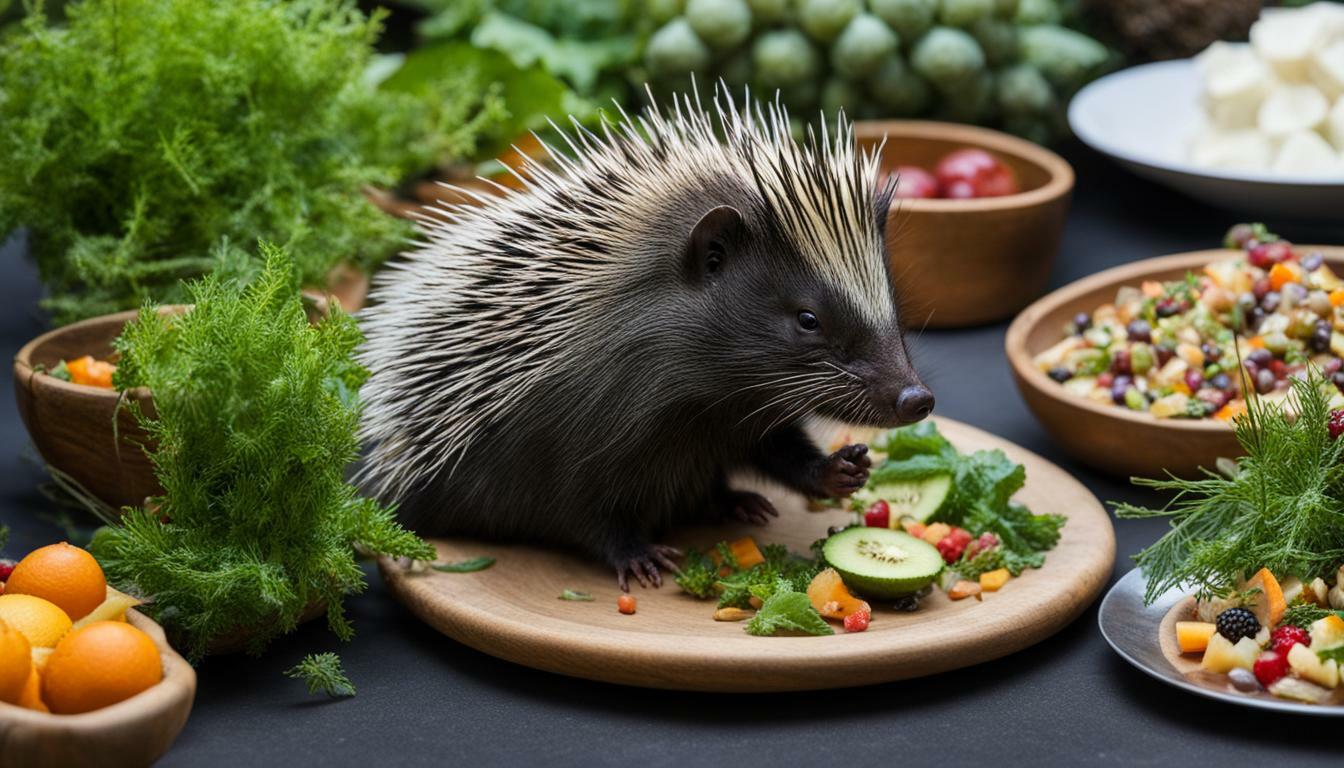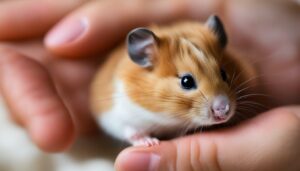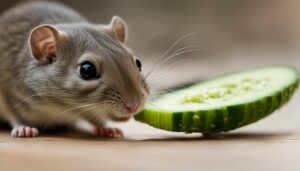Many people wonder about the dietary habits of porcupines and whether they are omnivores. In fact, porcupines are not omnivores but rather herbivores. They have a specific diet consisting primarily of leaves, twigs, bark, roots, fruits, and berries. While the North American porcupine often climbs trees to find food, the African porcupine forages on the ground. Porcupines have adapted to their herbivorous diet with specialized teeth for grinding plants. They also possess a unique defense mechanism with their sharp quills, which they raise and lash out with when threatened. Despite being solitary animals, porcupines may gather together in dens during bad weather. These fascinating creatures play an important role in the ecosystem and can live up to 10-15 years in the wild.
Key Takeaways:
- Porcupines are herbivores, not omnivores.
- Their diet consists of leaves, twigs, bark, roots, fruits, and berries.
- They have specialized teeth for grinding plants.
- Porcupines defend themselves with their sharp quills.
- They are solitary animals but may gather in dens during bad weather.
Understanding Porcupine Feeding Habits
Porcupines have unique feeding habits that are essential for their survival. As herbivores, they rely on a variety of plant-based food sources to meet their nutritional needs. The specific diet of a porcupine may vary depending on its habitat and availability of food.
Leaves, twigs, bark, roots, fruits, and berries make up the primary components of a porcupine’s diet. The North American porcupine is known to climb trees to find food, while the African porcupine forages on the ground. This adaptation allows them to access different food sources and maximize their chances of finding sustenance.
Porcupines have developed specialized teeth that aid in the consumption of plant matter. Their teeth are designed for grinding and chewing tough vegetation, allowing them to efficiently extract nutrients from their food. This adaptation ensures that porcupines can effectively digest and absorb the nutrients they require from their herbivorous diet.
Feeding Habits of Porcupines:
- Leaves
- Twigs
- Bark
- Roots
- Fruits
- Berries
Porcupines also possess a unique defense mechanism in the form of their sharp quills. When threatened, porcupines can raise and lash out with their quills, effectively deterring predators. This natural defense mechanism plays a vital role in their survival and serves as a deterrent, keeping potential attackers at bay.
While porcupines are primarily solitary animals, they may gather together in dens during bad weather conditions. This behavior provides them with additional protection and helps them conserve energy during unfavorable periods. Porcupines are adaptable creatures that have found ways to thrive in a variety of environments, contributing to the balance of their respective ecosystems.
In the wild, porcupines can live for approximately 10-15 years. Their lifespan, combined with their feeding habits and role in the ecosystem, highlights the importance of these fascinating creatures in maintaining the delicate balance of nature.
| Porcupine Feeding Habits | Food Sources |
|---|---|
| Leaves | Various tree leaves |
| Twigs | Small branches and twigs |
| Bark | Tree bark |
| Roots | Underground plant roots |
| Fruits | Fruit-bearing plants |
| Berries | Various berry bushes |
The Herbivorous Diet of Porcupines
Porcupines are considered herbivores due to their predominantly plant-based diet. They rely on a variety of plant foods to meet their nutritional needs. Some of the main sources of food for porcupines include leaves, twigs, bark, roots, fruits, and berries. The specific composition of their diet may vary depending on the species and their habitat.
The North American porcupine, for example, often climbs trees to find food, while the African porcupine forages on the ground. This adaptation allows them to access different types of vegetation and maximize their food options. Porcupines have also developed specialized teeth for grinding plants, which aid in efficiently consuming their herbivorous diet.
Porcupines have a unique defense mechanism with their sharp quills, which they raise and lash out with when threatened. This adaptation helps protect them from predators and ensures their survival in their natural environment. Despite their solitary nature, porcupines may gather together in dens during bad weather, providing them with additional protection and social interaction.
| Porcupine Nutrition | Porcupine Diet Composition | What Do Porcupines Eat |
|---|---|---|
| Primarily plant-based | Leaves, twigs, bark, roots, fruits, berries | Vegetation found in their habitat |
Porcupines play an important role in the ecosystem as they contribute to the balance of their habitats. They help control vegetation growth by consuming plants, which can prevent overgrowth and maintain a healthy ecosystem. In addition, porcupines serve as a food source for predators, further supporting the intricate web of life.
In their natural habitat, porcupines have an average lifespan of 10-15 years. With their herbivorous diet and unique adaptations, these fascinating creatures have found their place in the wild, thriving as integral members of their ecosystems.
Plant Foods in a Porcupine’s Menu
Porcupines rely on a variety of plant-based foods to meet their nutritional needs. These herbivores have adapted to their environment and have specific preferences when it comes to their diet. They primarily consume leaves, twigs, bark, roots, fruits, and berries, which provide them with the necessary nutrients for their survival.
The North American porcupine is known to climb trees to find food, while the African porcupine forages on the ground. This difference in behavior is influenced by their respective habitats and the availability of food sources. Regardless of their habitat, porcupines have developed specialized teeth for grinding plants, allowing them to efficiently process their plant-based diet.
Porcupines have a unique defense mechanism to protect themselves from predators. They possess sharp quills that they can raise and lash out with when threatened. These quills serve as a deterrent, making it difficult for predators to attack them. However, it’s important to note that porcupines will only use their quills defensively and will not shoot them out, as commonly believed.
Porcupines are solitary animals, but they may gather together in dens during bad weather or to seek protection. They typically prefer to live alone and have territorial behaviors, marking their territory with urine. Despite their solitary nature, porcupines play an important role in the ecosystem. They contribute to the balance of their habitats by influencing vegetation patterns and serving as a food source for other animals. In the wild, porcupines can live up to 10-15 years, depending on the species and environmental conditions.
| Plant Foods Consumed by Porcupines | Examples |
|---|---|
| Leaves | Oak leaves, maple leaves, ferns |
| Twigs | Small branches, young tree shoots |
| Bark | Pine bark, willow bark |
| Roots | Grass roots, herb roots |
| Fruits | Apples, berries, melons |
| Berries | Blueberries, raspberries, strawberries |
Foraging Behavior of Porcupines
Porcupines exhibit specific behaviors to find and consume their preferred plant foods. The North American porcupine, for example, is known to be a skilled tree climber, often scaling branches in search of leaves, twigs, and bark to eat. On the other hand, the African porcupine forages on the ground, feeding on a variety of roots, fruits, and berries.
These nocturnal animals have a keen sense of smell that helps them detect and locate food sources. They use their sharp front teeth to gnaw through tough plant materials, such as tree bark or fibrous roots. Porcupines have a slow chewing technique, taking their time to grind down their food into manageable pieces.
Feeding Habits of Porcupines
Porcupines have a generalized diet, consuming a wide range of plant foods. Their food preferences may vary depending on the availability and seasonality of certain plant species. For instance, during the winter months, when fresh plant growth is limited, porcupines rely more on the inner layer of tree bark and twigs for sustenance.
| Food Sources | Examples |
|---|---|
| Leaves | Maple leaves, oak leaves, aspen leaves |
| Twigs | Pine twigs, willow twigs, birch twigs |
| Bark | Tree bark, especially inner bark |
| Roots | Grass roots, herb roots, tubers |
| Fruits | Apples, berries, grapes |
Porcupines have evolved to extract maximum nutrition from the plant materials they consume. Their digestive system is designed to break down and extract nutrients from the cellulose-rich plant matter. This allows them to efficiently extract energy from their herbivorous diet, despite the relatively low nutritional value of many plants.
Overall, porcupines’ foraging behavior and their adaptation to a herbivorous diet are essential aspects of their survival and thriving in various ecosystems.
Adaptations for a Herbivorous Diet
Porcupines have developed unique adaptations to effectively consume plant material. Their specialized teeth play a crucial role in processing and grinding tough plant matter. These teeth are well-suited for the porcupine’s herbivorous diet, allowing them to break down fibrous plant material efficiently.
One of the key adaptations is the porcupine’s constantly growing incisors and molars. As they chew on tough vegetation, the grinding action wears down their teeth, but they continuously grow to compensate for this. This ensures that the porcupines always have sharp and efficient teeth for consuming plant matter.
In addition to their teeth, porcupines also possess strong jaw muscles that provide the necessary force for grinding and chewing. This muscular jaw structure allows them to exert significant pressure while consuming tough plant material.
To support their herbivorous lifestyle, porcupines also have a long and flexible tongue. This enables them to reach and grasp small leaves and twigs while feeding. Their dexterous tongue, combined with their sharp teeth and strong jaws, allows them to strip leaves from branches and consume various parts of plants.
Table: Porcupine Adaptations for a Herbivorous Diet
| Adaptation | Description |
|---|---|
| Specialized teeth | Porcupines have constantly growing incisors and molars that are well-suited for grinding tough plant matter. |
| Strong jaw muscles | Porcupines possess powerful jaw muscles to exert pressure while chewing and grinding plant material. |
| Long and flexible tongue | Porcupines have a long and flexible tongue, enabling them to reach and grasp small leaves and twigs while feeding. |
Defense Mechanism – Sharp Quills
Porcupines use their sharp quills as a defense mechanism when facing threats. These quills are their primary form of protection and serve as a deterrent to predators. When a porcupine feels threatened, it raises its quills, making them stand erect and creating a formidable barrier.
The quills are modified hairs that have a sharp, barbed tip, making them difficult to remove once embedded in an attacker. They are coated with a waxy substance that may cause irritation, infection, or even death if they penetrate the skin of an animal. This defense mechanism is highly effective in deterring predators and avoiding potential danger.
Physical Characteristics of Porcupine Quills:
| Length | Color | Texture |
|---|---|---|
| Up to 4 inches | Black, brown, or white | Solid and rigid |
Porcupines have an average of 30,000 quills on their bodies, which can be easily raised and controlled by muscular contractions. The quills cover their back, sides, and tail, providing them with maximum protection against potential attackers. Contrary to popular belief, porcupines cannot actively shoot their quills at their enemies, but rather rely on contact with the quills to cause harm.
While these sharp quills serve as an effective defense, they are not used offensively and porcupines prefer to avoid confrontation whenever possible. By raising their quills and displaying their formidable armor, porcupines are often successful in warding off predators and ensuring their own safety in the wild.
Social Behavior and Sheltering Habits
Porcupines typically lead solitary lives but may seek shelter together during inclement weather. These fascinating creatures are known for their independent nature, preferring to forage and navigate their surroundings alone. However, when faced with harsh weather conditions like heavy rain or snowfall, porcupines may gather together in shared dens for protection.
Their denning behavior serves as a temporary refuge from the elements, providing warmth and safety in numbers. These communal dens are often located in hollow trees, rock crevices, or underground burrows. Porcupines may take turns occupying the den, rotating between individual shelters throughout the day.
During these sheltering periods, porcupines maintain their solitary behavior, avoiding excessive social interaction. They establish separate spaces within the den, respecting each other’s personal boundaries. This unique balance ensures that they can share a common space without infringing upon one another’s territory.
While their social behavior may be limited to these temporary sheltering periods, the ability of porcupines to adapt and cooperate when necessary demonstrates their resilience and survival instincts in the face of challenging weather conditions.
Table 1: Sheltering Habits of Porcupines
| Behavior | Description |
|---|---|
| Solitary Behavior | Porcupines prefer to lead solitary lives, foraging and moving independently. |
| Communal Sheltering | During bad weather, porcupines may seek shelter together in shared dens for warmth and protection. |
| Respect for Personal Space | While sheltering together, porcupines establish separate spaces within the den, respecting each other’s boundaries. |
Role of Porcupines in the Ecosystem
Porcupines play a crucial role in their respective ecosystems. As herbivores, they have a direct impact on plant populations and vegetation structure. By consuming leaves, twigs, bark, roots, fruits, and berries, porcupines help in shaping the composition and distribution of plant species within their habitat.
The feeding habits of porcupines also contribute to seed dispersal. As they consume fruits and berries, they inadvertently transport seeds within their digestive system, aiding in the dispersal of plant species across different areas. This process promotes plant diversity and helps in the regeneration and colonization of new habitats.
In addition to their role in plant dispersal, porcupines also serve as prey for various predators. Their presence in the food chain supports the survival and population dynamics of predators such as large birds of prey, wolves, and cougars. By maintaining a balance between herbivore and predator populations, porcupines contribute to the overall stability and health of their ecosystems.
| Role | Impact |
|---|---|
| Plant Consumption | Shapes plant populations and vegetation structure |
| Seed Dispersal | Aids in the spread of plant species |
| Prey | Supports predator populations |
Overall, the presence of porcupines in ecosystems promotes ecological balance, biodiversity, and the sustainability of plant communities. Their unique feeding habits and role as prey animals highlight their importance as key contributors to the intricate web of life.
Lifespan of Porcupines
Porcupines have an average lifespan of 10-15 years in the wild. These intriguing creatures, known for their spiky quills, have adapted to survive in various habitats around the world. While their lifespan may seem relatively short compared to other animals, porcupines make the most of their time by playing crucial roles in their ecosystems.
North American porcupines, for example, roam the forests and woodlands of North America, while African porcupines thrive in the grasslands and forests of sub-Saharan Africa. Despite their different habitats, both species share a similar dietary preference for plant-based foods.
Dietary Adaptations
Porcupines are herbivores, primarily consuming leaves, twigs, bark, roots, fruits, and berries. They have specialized teeth that are perfect for grinding down plant matter, allowing them to extract nutrients effectively from their food sources. The North American porcupine often climbs trees to find food, while the African porcupine forages on the ground, using its strong sense of smell to locate vegetation.
Defense Mechanism and Social Behavior
Porcupines have a unique defense mechanism that sets them apart from other animals. Their quills, which cover their bodies, are sharp and barbed, providing effective protection against predators. When threatened, porcupines raise their quills and, if necessary, lash out with them in an attempt to deter their attacker. Despite this formidable defense, porcupines are generally solitary animals, preferring their own space. However, during inclement weather, they may gather together in dens for protection.
Ecological Importance
In the grand scheme of things, porcupines play a crucial role in the ecosystems they inhabit. By consuming various types of vegetation, they contribute to the balance of plant populations and help maintain the health of their habitats. Additionally, porcupines serve as a source of food for predators, further illustrating their importance in the intricate web of life.
| Species | Habitat | Primary Food Sources |
|---|---|---|
| North American Porcupine | Forests and woodlands of North America | Leaves, twigs, bark, roots, fruits, and berries |
| African Porcupine | Grasslands and forests of sub-Saharan Africa | Leaves, twigs, bark, roots, fruits, and berries |
In conclusion, porcupines are fascinating creatures with a relatively short lifespan of 10-15 years in the wild. As herbivores, they have adapted their teeth to grind plant matter and rely on leaves, twigs, bark, roots, fruits, and berries for sustenance. Their sharp quills serve as a powerful defense mechanism, while their solitary nature and denning habits offer protection during unfavorable conditions. Despite their solitary lifestyle, porcupines fulfill a vital role in the ecosystem by maintaining plant populations and providing sustenance for other animals.
Conclusion
In conclusion, porcupines are not omnivores but rather herbivores, subsisting on a plant-based diet. They primarily eat leaves, twigs, bark, roots, fruits, and berries, depending on their natural habitat and availability of food sources. The North American porcupine, for example, often climbs trees to find food, while the African porcupine forages on the ground.
Porcupines have adapted to their herbivorous diet with specialized teeth for grinding plants. Their teeth are well-suited for breaking down tough plant material, allowing them to efficiently extract nutrients. This adaptation enables porcupines to thrive on a diet consisting solely of plants and vegetation.
One of the distinctive characteristics of porcupines is their unique defense mechanism – their sharp quills. When threatened, porcupines raise and lash out with their quills, deterring potential predators. These quills are effective in protecting porcupines from harm and make them a formidable presence in their environment.
Porcupines are solitary animals, preferring to live alone rather than in groups. However, during unfavorable weather conditions, they may gather together in dens for shelter and protection. This behavior allows them to endure harsh conditions and ensures their survival in challenging environments.
Porcupines play an important role in the ecosystem. They contribute to the balance of their habitats by dispersing seeds through their feeding habits and acting as prey for larger predators. Their presence has a significant impact on the overall health and biodiversity of their respective ecosystems.
In the wild, porcupines can live up to 10-15 years. This lifespan allows them to fulfill their ecological role and maintain stable populations within their habitats. By understanding the dietary preferences, behaviors, and lifespan of porcupines, we gain valuable insights into the fascinating world of these intriguing creatures.
FAQ
Are porcupines omnivores?
No, porcupines are not omnivores. They are herbivores, meaning they primarily eat plant-based foods.
What do porcupines eat?
Porcupines eat leaves, twigs, bark, roots, fruits, and berries.
Where do porcupines find their food?
Porcupines can climb trees to find food, like the North American porcupine, or forage on the ground, like the African porcupine.
How do porcupines adapt to their herbivorous diet?
Porcupines have specialized teeth for grinding plants, which helps them digest their food effectively.
What is the defense mechanism of porcupines?
Porcupines have sharp quills that they can raise and lash out with when threatened.
Are porcupines social animals?
Porcupines are solitary animals, but they may gather together in dens during bad weather.
What is the role of porcupines in the ecosystem?
Porcupines play an important role in the ecosystem by contributing to the balance of their habitats.
How long do porcupines live in the wild?
Porcupines can live up to 10-15 years in the wild.




